Are You An SEO Guru?
- Well-planned Content Strategy
- Engaging Copywriting
- Unique Sales Proposition
So if you were to start your online business right now, what would be the most crucial milestone to hit?
You guessed it!
AWESOME CONTENT PLANNING!
Whether or not you are an:
- “SEO-newbie” who has minimal experience
- agency managing a plethora of clients
- affiliate marketer building an affiliate website empire
I am here for you!
My objective is to do all the research for you and tell you what is considered “hip” in your niche, the best way to organize your content into thematic entities and, most importantly, how to properly communicate your awesome ideas with the “Big G”.I, Keyword Cupid, promise to be your dedicated keyword matchmaker with one and only goal;
to help you create the most effective, elaborate and accurate content plan for your online business!
There is NO reason to rely on arbitrary opinions, gut feelings or guesses to decide which article to publish!
There is NO reason to spend your precious time researching what your competitors are writing about.
You have an important business to run!
I got you!
We can’t stress TL;DR enough!
this is a long post geared towards only the people who are very interested in what makes me better than all the other “copycats” out there.
If you are too busy to read my whole life story, here is what you need to know:
I am great (jk), just jump on the app, upload your keyword list, press Run Now and I will email you when I have something that looks like this:
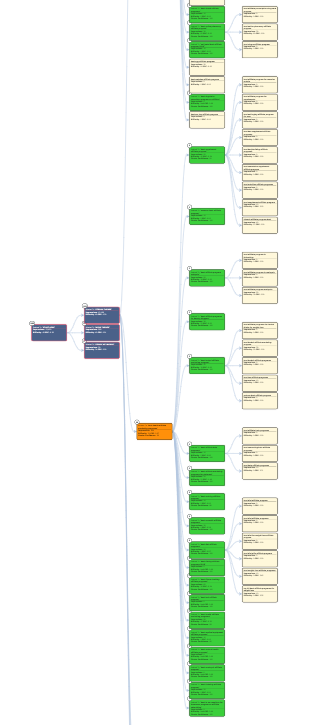
Keep reading and ALL YOUR QUESTIONS about life will be answered and ALL YOUR DREAMS are going to be fulfilled! 😊
Is Content King?

There is already plenty of literature available on how to collect a list of high-rewarding keywords. [1], [2], [3]
The underlying theme across all these guides is to identify a list of potential terms (also known as "keywords") that maximize the forecasted impressions per month while minimizing these terms' estimated difficulty.
Who are you writing for?
Strict reliance on these metrics and a set keyword list can distract you from the real reason that drove the user to visit your page in the first place.
So WHO do you optimize your content for?
Do you write a compact piece of content that targets only the most searched keywords?
Or…
Do you dive in and create multiple pages that go in-depth on every topic of that niche?
The last option sounds good in theory.
However, this approach has a major problem, which we will discuss in the next section! (hint: content cannibalization)
This doesn’t mean you should limit your content either!
There is another option that will optimize for both user intent and search engine visibility.
Keep reading to find out how Keyword Cupid can help you do it ALL!
Our Objective
This analysis aims to help our client's law office improve its content strategy to achieve search engine visibility for relevant terms while publishing articles that capture the whole spectrum of the user intent.
Our content planning strategy intends to consider potential keyword cannibalization issues that may occur if two pages are competing for the same terms in the eyes of Google.
All in all, we want to:
- Discover which themes our users care most about
- Maximize the potential impressions a page can get
- Avoid creating multiple pages that can rank of the same terms (challenging)
Oomph, sounds like a lot, right?
Not really!
You can do this in 5 minutes!
Leave it to us.
Just input your campaign info, grab a cup of your favorite beverage, talk to your spouse, connect with your kids, and I will prepare everything for you to review later.
Let me show you how.
Keyword Research With Semrush
Semrush is a leading tool in SEO, packing many features and capabilities around link building, keyword research, competitive analysis, PPC campaigns, etc.
It is a fundamental tool for any marketer that wants to gain a competitive edge over their competition and analyze the entire spectrum of their site’s niche.
Analyze Your Competition

Semrush’s functionality allows us to see that this practice doubled down on their online advertising efforts in January 2017 and have since grown tremendously.

When a site like this one has been around for a while, it begins to rank for various terms that are not a direct outcome of their advertising strategy but a byproduct of how Google’s ranking algorithm works.
To focus only on the keyword relevant to their marketing strategy, I limited the keyword list to only those our competitor is ranking for in Google’s first two pages.
This leaves 631 keywords that we are confident are relevant to the specific set of problems they are trying to solve.
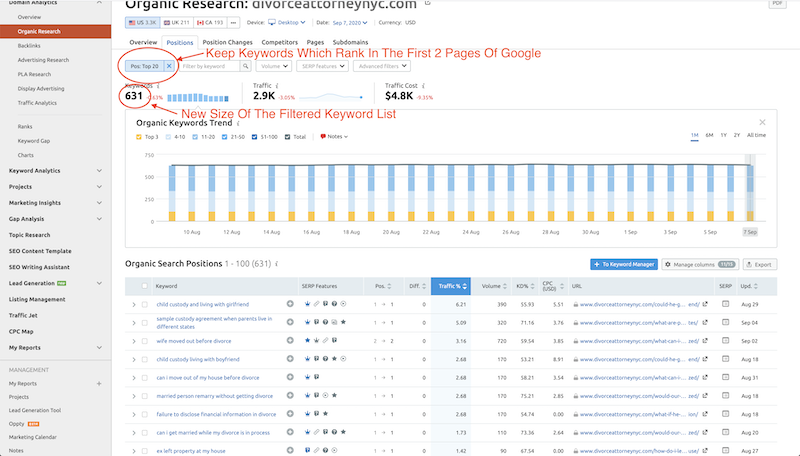
Simple.

Semrush Keyword Magic
Its name is self-explanatory; you provide a seed keyword and their internal algorithm will find all the relevant keywords.
Obviously, words have different meanings depending on how they are used.

The seed keyword “child custody” generated over 45k keywords, which seemed excessive.
I just want to focus on a set of targeted keywords that represents our objective, damn it!!!


Using Semrush’s “exclude keyword” functionality, you can remove all the keywords that include a state name or abbreviation, except the ones from New York that we are targeting.
I also decided to keep terms with at least 100 forecasted impressions per month, and an estimated difficulty below 70.
After all, what’s the point of optimizing for difficult keywords with no searches after all?
Perfect!
This shrunk the list of keywords to 127 keywords, which is fine as we care more about quality than quantity.


Finalizing The Keyword List
If you only pulled an organic analysis, no reformatting would be required because Keyword Cupid can understand the proper structure of reports pulled directly from Semrush.
However, I am merging two types of reports, so we must format it so that the tool understands what we are uploading.


This is why we need to do an extra step to combine them.
In this example, as our report is “Custom” made, we need to take a different approach to upload.
Our portal expects you to upload your data in a tabular format, like an Excel spreadsheet. The first line of the table should be the header, with four different columns: “Keyword,” “Volume,” “Difficulty,” “CPC”. Don’t worry, if you happen to make a mistake, the interface will notify you of any missing columns.
Below is a sample of the final Excel file’s first few rows after merging the two lists.
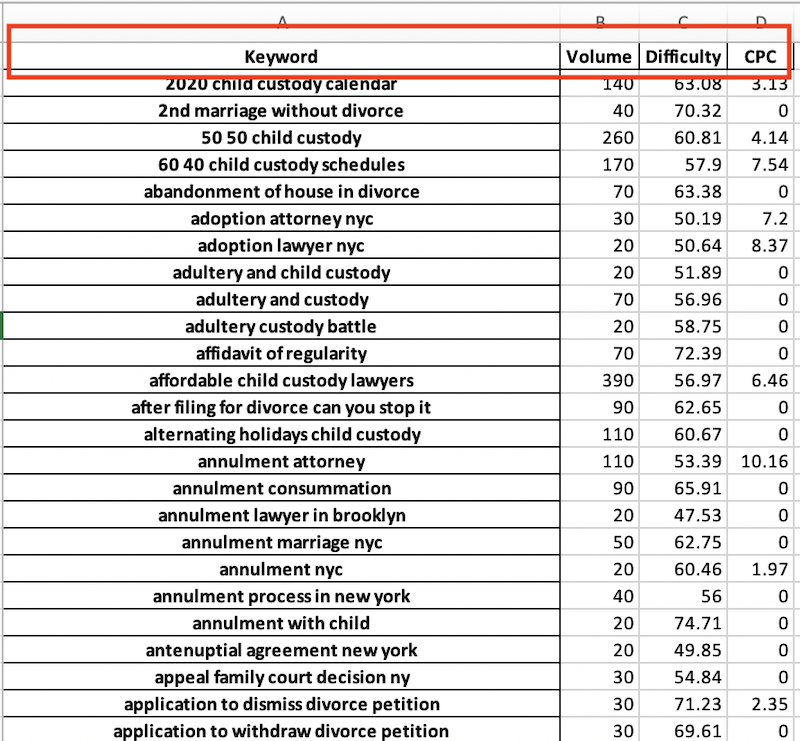
What Now?!
That’s great news, but you may ask:
-
What am I supposed to do with this? Should I make a page for every keyword?
(No, that seems silly. We would end up with 735 new pages) -
Am I supposed to put the keywords that have similar words on the same page?
(Hmm, “attorney” has so many variations. That would have to be a pretty extensive page) -
Am I supposed to use the Google NLP toolkit
[6] to find out the significant entities and target those with the highest saliency score?
(Ugh, scratch that, it makes no sense)
Machine Learning To The Rescue
Who can tell us how to rank these keywords better than Google itself?
For each keyword, Google “reveals its hand” and shows us exactly what it considers relevant.

Thankfully Google has done all the heavy lifting and shows us the most trustworthy sources of information (supposedly) in the first results.

Of course, I place a heavier weight on matches on the 1st page than a match on the 5th page.
My weighting curve follows the same exponential curve as the Ahrefs keyword difficulty score[7].
Multi-dimensional what?

In other words, using trigonometry, I create an equation that will show us which keywords are closest to each other.
I use a maximum of 100 dimensions, which, unfortunately, the human mind cannot visualize.
Being a figment of my developer’s imagination has its merits :)
“Mr. Picky” & “Mrs. Chill”
I use two kinds of neural networks (without really understanding how they really work).
The first neural network is a very harsh one; let’s call it “Mr. Picky” [8]. "Mr. Picky" focuses on grouping together the keywords you uploaded in very tightly themed clusters.
"Mr. Picky" wants to ensure that at least the first level clusters will be correct, even if he neglects some keyword relationships that would otherwise make sense.
That’s where “Mrs. Chill” comes to play, our second neural network [9].
“Mrs. Chill” focuses on grouping the clusters “Mr. Picky” created and uses a set of relaxed rules in its neurons to allow for more "flexible” relationships".
Think of “Mr. Picky” and “Mrs. Chill” as the good cop/bad cop duet.
The First TRULY Unbiased Keyword Research Tool
Although it’s a “hot topic,” I deliberately didn’t want to use any NLP algorithm, TF-IDF, or other relevancy scores to group keywords together.
I also avoided hard cutoff limits that indicate the number of SERP overlap indicating a strong relationship.
Maybe 2 SERPs, perhaps 3, is enough.
Maybe 0 overlap is enough to determine a match if there is a transitive relationship because of other keywords!
Regardless, heuristics are hardly ever a good idea as they require manual testing when the underlying algorithms change.
If Google comes up with the next version of its language model and becomes even smarter, our results will become better.
If the world as we know it changes, and let’s say Corona, instead of being a popular beer brand, becomes a pandemic virus that brings the world to its knees, our clusters will detect the new intent.
We want YOU to WIN!
How To Use Keyword Cupid
Bring Your Own Data Reports
Go to the dashboard and make sure you have the “B.Y.O.D. Report” (Bring Your Own Data) selected.

Trust me, this extra step will only help you organize your results better and collaborate with your team easier.
If you don’t have a project already created, click on the three dots on the top right corner of the project panel and click “Add New Project”.
Fill the form with a relevant name and a description (optional).


Congrats, you created your first project!
Now back to finish creating a report.
Fill in the relevant information in the New Report form.
By clicking on the data provider dropdown, you can select the tool from which your data is pulled.
This will help us understand which formatting to look for.
In our case, since we created the dataset ourselves, click “Custom” and “All Metrics”.
This means that you want to see all statistics about Impression Volume, Difficulty, and CPC aggregated in your clustered results.
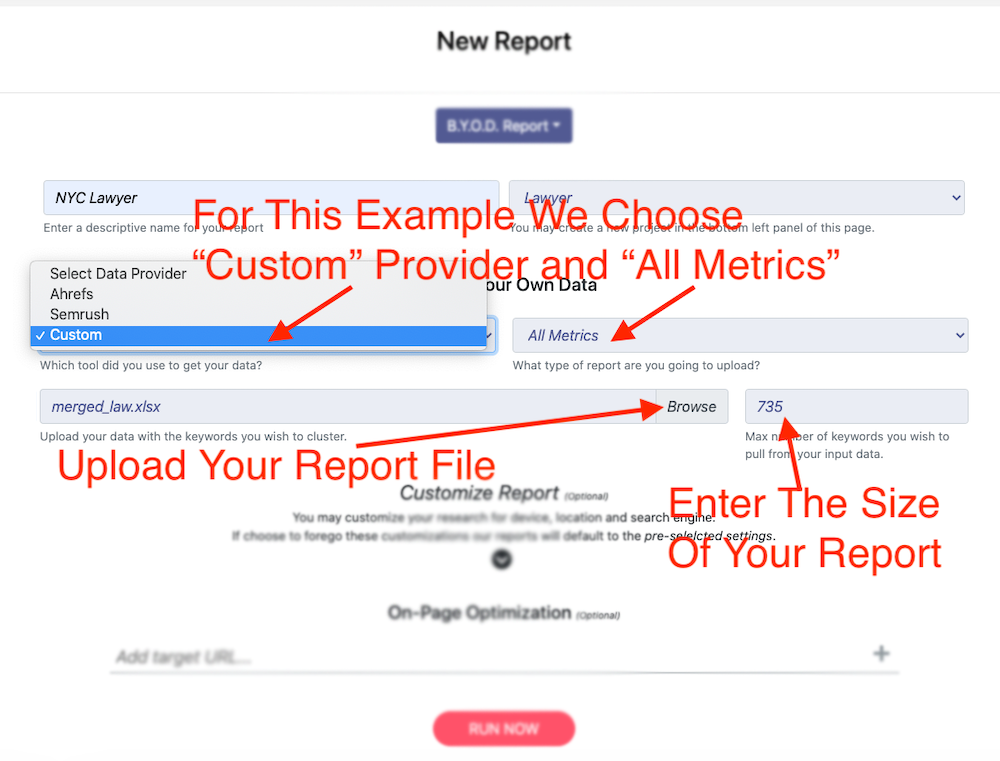
Customize Your Report
To account for this in your business case, you can specify the exact location you want to target.
If you want even more control, I can use the results from a laptop, mobile, or tablet.
This will be particularly useful for people targeting foreign SEO, as the results will be vastly different due to language differences.
You can also select a search engine other than Google if you wanted to analyze how different search engines “perceive” the same keywords.
Since our client is local, we allowed our headquarters’ default location in NYC and targeted mobile devices (because it’s cool).

Scrape On-Page Elements
I visit and scrape a dozen on-page elements such as header tags, bolded keywords, contextual links, etc. to identify which elements of the page are optimized and for which keywords.
You can use this as a first assessment of how your competition is tuning their on-page strategy to target a cluster of keywords.
For this example, I am going to target 3 of our client’s main competitors URLs.
Don’t worry, I am wearing a trench coat, hat, and sunglasses, no one will see me!
You can simply input the URLs of your choice in the field and click the + button.

I also do Guest Posts… nah, just kiddin’.
That’s it!!!
Simply click RUN NOW and then click Continue on the confirmation screen.

Your report was submitted successfully.

Then I am going to pass the SERPs to “Mr. Picky” and “Mr. Chill”.
Depending on the size of your report, the jobs might take a few hours to complete.
Not to be TMI, but they do fight a lot.
You can track the status of your report on the main dashboard.


HOORAY!!!

Keyword Cupid Outputs
Clusters For Dayzzz
- an interactive dendrogram, which you will be able to expand by clicking on each node.
- an Excel report that may be more usable for delegating tasks and sharing with your team.
Interactive Mindmap
All the mindmaps start with the same format;
three main nodes meant to segment and organize your results by theme strength to navigate them better.
On the top left of each node, I denote the number of keywords contained in all of its branches.

He wasn’t confident that the intent/theme derived from the SERPs were strongly correlated, so it’s best to try another time.

The clusters in this branch can still be very related to each other and there might even be a lot of exciting ideas for topics, such as the example in the picture below about “failed drug test and child custody” (ouch).
The keywords from your input are always going to appear in the leaves of the tree and their nodes will be colored beige.
The impressions, difficulty, and CPC metrics are aggregated in the higher levels and always stem from the original keywords found in the report.

It makes sense to spend the majority of your time in this branch.
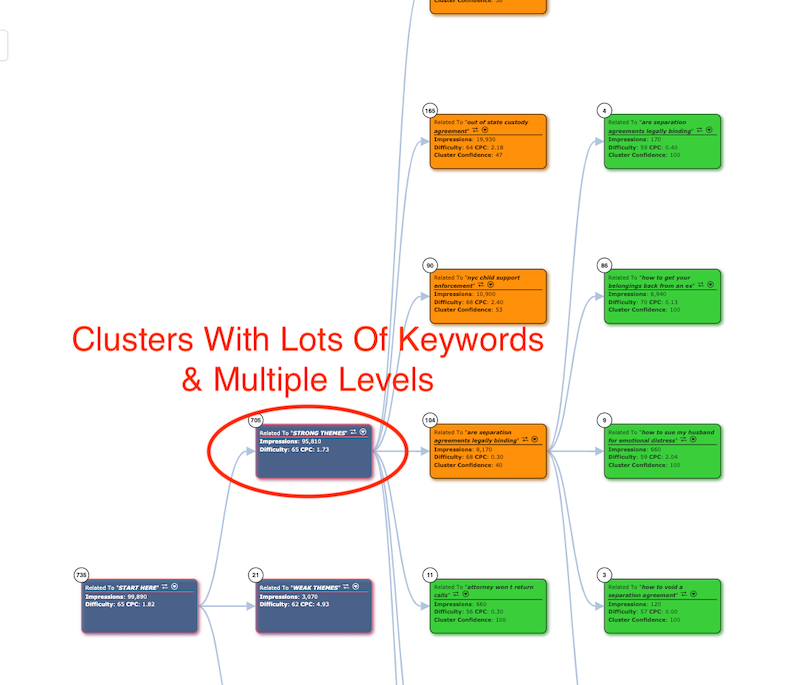
What Is Cluster Confidence?
Therefore we created a metric that will show how confident, or not, we are about a grouping and let you decide.
When referring to the cluster confidence, we denote the “closeness” of the results inside that branch of the tree.
There are three colors that a cluster node could have;
-
Red
The children of that node don’t have much in common. -
Orange
There is some similarity between this node’s children, but they are not strongly themed. -
Green
There is a very tight relationship between the children of that node.
You should exercise caution when creating silos and hubs based on these and only connect the ones that make the most sense intuitively.
When a cluster is green, especially when the “Cluster Confidence” is 100, we are confident that this node’s children are all related to each other.
This means that the subsequent keywords’ pages can be interlinked with proper anchor text that emerges from each node’s theme.
Should I use the name of the cluster as the name of the page?
The keyword that is the center point of this “cloud of data points” is called the “centroid”.
This centroid acts as the label of the resulting cluster.
In other words, it serves as a representation of the themes inside the node.
Nevertheless, it does not necessarily point to the name of the URL slug you should use for that page.
Example
The cluster itself has a confidence of 40, which means that the branches inside are loosely connected, but there is still some underlying relationship.
This becomes apparent when you expand the node and inspect the child clusters.

However, there is no indication that all these sub-clusters should belong in the same hub of pages.
Let’s dive a bit deeper.
When I select the cluster labeled “how to get your belongings back from an ex,” I see this cluster has a confidence of 100 and a total impression volume of almost 7k views per month.

Expanding each vertical identifies even more tightly related topics.
Would you have grouped the intent of “getting your belongings back from an ex” on the same page as the conversation about “getting your belongings back from someone”?
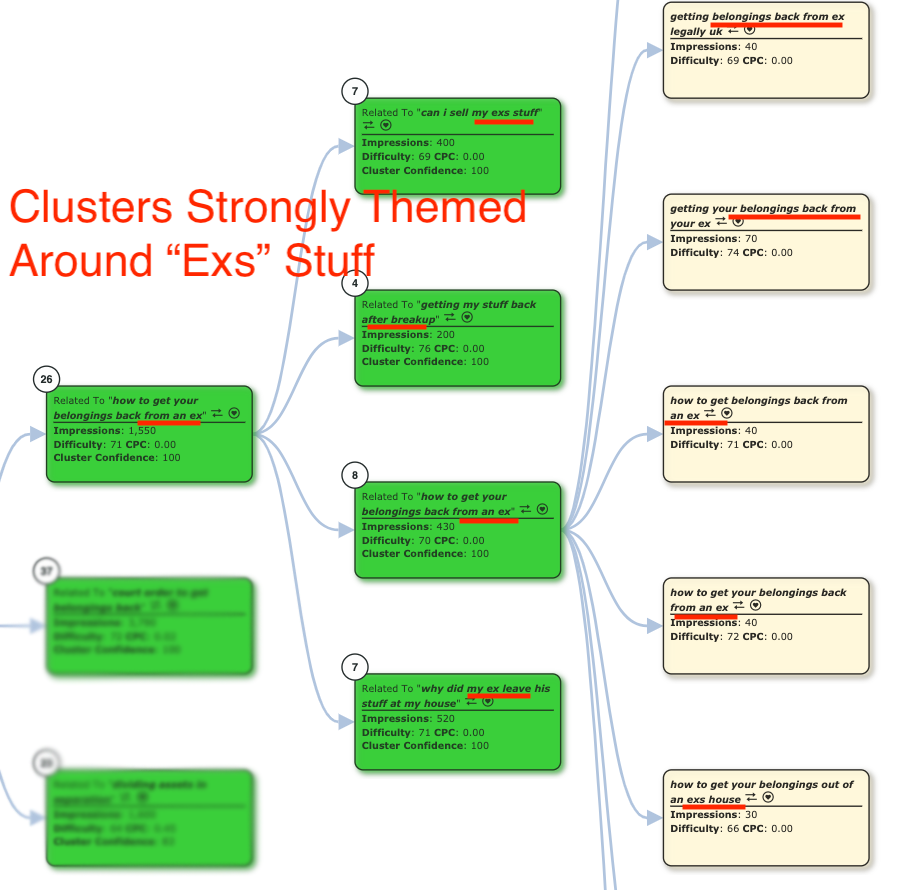

If you look carefully at all the keywords grouped together, you will see they are all perfectly organized without a single one out of place!
Excel Version
Therefore I choose to display the most meaningful dimension: the lower-level clusters that segment your input keywords.
Inside each sheet, you can find all the relevant information for each cluster and on-page statistics that we will discuss in the next session.

The first sheets you examine are those that have the most forecasted views and the highest cluster confidence.
All the aggregate metrics in the Excel sheet are calculated formulas, which means that they update automatically in case you want to edit the sheet.
On-Page Recommendations
Knowing how to optimize the critical elements of your web page is a whole other ball-game.
While I don’t claim to be an on-page optimization guru, I still provide some initial insights on how the keywords you submitted appear on the page you want to target.
By clicking on the toggle in the top left corner, you can switch the metrics displayed for the clusters to the on-page element counts.

For the cluster level nodes (green, orange, and red nodes), the counts are total underlying keywords that appear within the respective on-page element of this URL.
For example, we can see three keywords in the cluster “divorce lawyers in NYC free consultation” that appear in the title of the URL selected.

Nothing super complicated, but it works.
We can see that the title of the page is heavily tuned to divorce consultation, which also happens to be the focus of this lawyer.
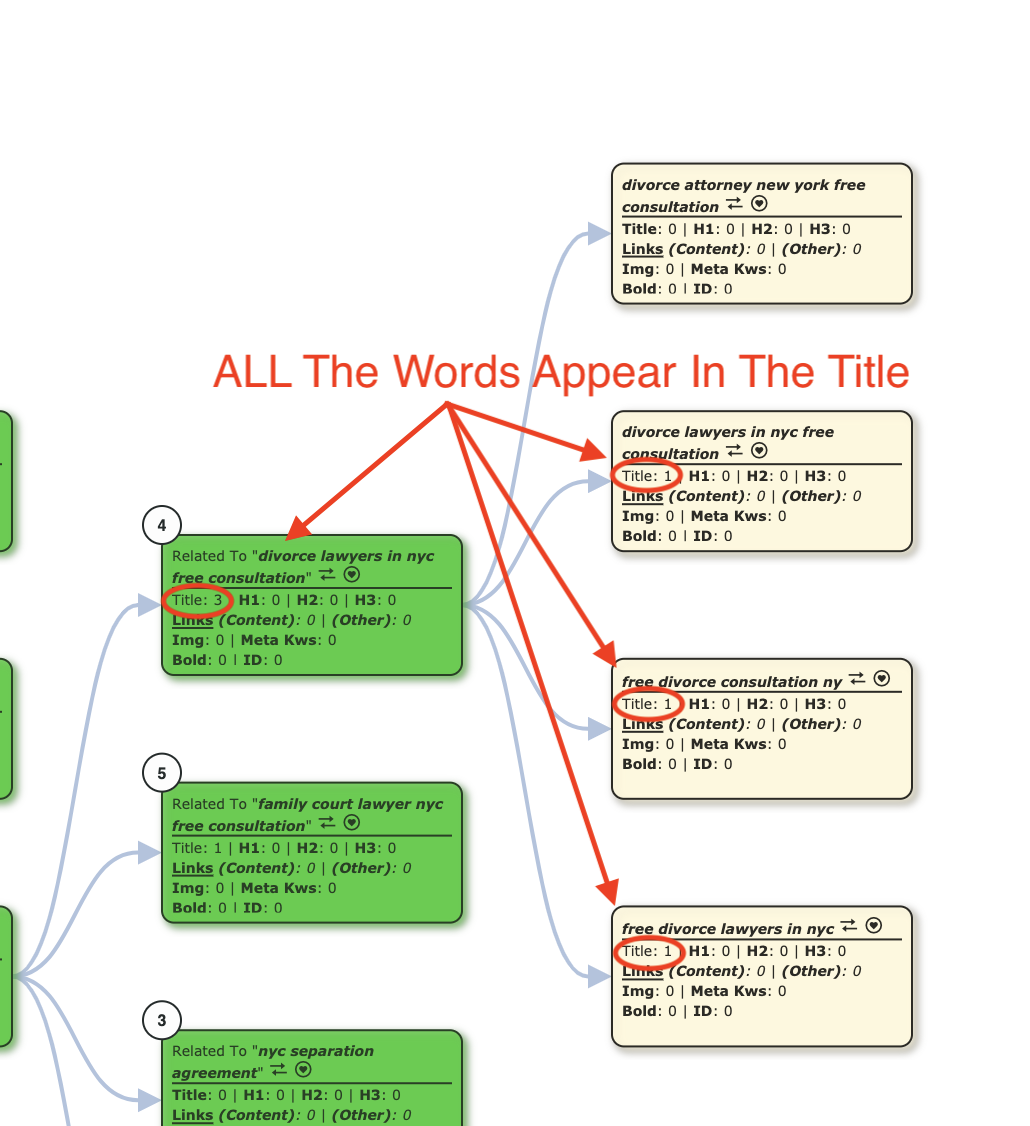

For example, if we want to target the cluster “antenuptial agreement new york,” which contains five keywords, we can click on the heart icon (my name is Cupid after all) beside the node’s title.

The idea is that this phrase will best represent all keywords within the cluster.

Putting Keyword Cupid To Practice
Writing Content
Therefore, it makes the most sense to focus on clusters related to child custody keywords.
Specifically, two clusters jump out straight away.

There was also a vertical of people searching for pro bono lawyers as they probably cannot afford the legal fees.

In this particular case, we primarily want to create more content that provides information about the subject, so these are not the right keywords to focus our energy on.
Instead, I concentrated more on the cluster “child custody for fathers”.
This cluster has 16 underlying keywords and 3,400 total impressions per month, which seems promising.
By glancing over the cluster keywords, I can easily see its theme caters to fathers who seek custody of their children.

Particularly with this cluster, the supporting keywords are all heavily connected to cases where the mother has a mental illness such as bipolar disorder or is suicidal.

Quite frankly, I’d much rather talk about love and happy things.
But I also have to buy new arrows...
Content Outline

- Page URL: /fathers-child-custody/
- Title/H1: Child Custody For Fathers
- H2: Child Custody Rights For Fathers
- H2: How To Win Child Custody If You Are A Father
- H2: Child Custody Cases Where The Father Won
- H2: How To Deal With Harassment During Child Custody Proceedings

- Page URL: /fathers-child-custody/dealing-with-a-spouce-with-mental-illness/
- Title/H1: Parents With Mental Illness And Child Custody Issues
- H2: Proving Mental Illness For Child Custody
- H3: Custody Battle With A Suicidal Mother
- H2: Winning Child Custody For Dads When Mother Is Bipolar

- Page URL: /fathers-child-custody/dealing-with-a-narcissist/
- Title/H1: Dealing With A Narcissistic Parent
- H2: Dealing With A Narcissist Over Child Custody
- H2: How To Get Child Custody From A Narcissist
For example, I will create a link from /dealing-with-a-spouse-with-mental-illness/ to /dealing-with-a-narcissist/ with the anchor text “how to deal with a narcissist” and vice versa.
That’s it!
Final Remarks
Oomph, that was a lot.. but.. YOU MADE IT!!! 🎉🎉🎉
Congratulations, you are the chosen one!
In all seriousness, if you read the whole thing, please send us a message and tell us what you think.
Do you still think that you need extensive SEO experience or any elaborate domain expertise to create mind-blowing articles for your audience?
Would you remember all these keywords and figure out how to structure them together in an accurate and replicable manner?
If yes, what would your approach be?
In a year, would you be able to easily ensure that your page is relevant?
What if your brand becomes the name of another pandemic outbreak?
How would you determine what the relevant keywords that need to be included in your page are?
When you are creating a new page, how would you be sure that none of your other pages will compete with this new one and start “cannibalizing” each other?
If you also share our post on Facebook and spread the keyword love, we might send you your own honorary KC arrows!

We are excited to hear all about your experience.
Till next time.
- https://www.semrush.com/blog/keyword-research-guide-for-seo/
- https://ahrefs.com/blog/keyword-research/
- https://moz.com/beginners-guide-to-seo/keyword-research
- https://www.semrush.com/features/organic-research/
- https://www.semrush.com/features/keyword-magic-tool/
- https://cloud.google.com/natural-language/docs/analyzing-entities
- https://ahrefs.com/blog/seo-metrics/#section5
- http://citeseerx.ist.psu.edu/viewdoc/summary?doi=10.1.1.49.9280
- https://www.sciencedirect.com/topics/engineering/recurrent-neural-network








